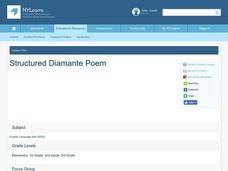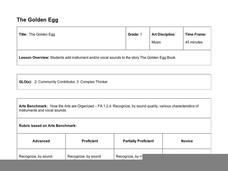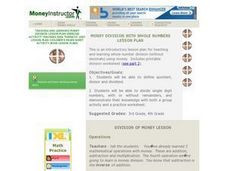Curated OER
Pizza Biography
A biography writing lesson with a tasty twist! Kids create a "visual biography" in which each pizza slice represents a paragraph, and toppings represent supporting details. They learn research techniques, note-taking skills, and how to...
Curated OER
All Americana
Fifth graders research American landmarks and symbols. In this United States history instructional activity, 5th graders create a KWL chart about the symbols of America and take notes during a PowerPoint presentation. Students complete...
Curated OER
Structured Diamante Poem
Youngsters review nouns, adjectives and verbs. In this poetry lesson, readers choose a set of antonyms and create a list of synonyms, verbs and adjective for each. Students use the words to write a Diamante poem.
Curated OER
Talking Rocks
Artists imitate the symbols used by tribes of the Southwest or use their own word pictures that communicate something about themselves. This instructional activity is a perfect blend of visual art and social studies. Students create a...
Curated OER
Huichol Yarn Painting
Young artists of many ages apply yarn painting techniques in combining their ideas and their art. After viewing actual examples of yarn paintings created by the Huichol people, learners choose an important scene from their own lives...
Curated OER
Nutrition In Me! Club
Students practice food safety and hand washing. In this health lesson, students discuss the presence of germs and how to keep yourself safe. Students wash their hands after applying Glo-Germ to see what spots they missed.
Hawaiʻi State Department of Education
The Golden Egg
Get ready for a musical story time! First your young musicians review musical dynamics as they listen to and discuss the pitch and sound of each instrument you play for them. Then they talk about special words (mostly verbs) in the book,...
BW Walch
Creating Linear Equations in One Variable
The example of two travelers meeting somewhere along the road has been a stereotypical joke about algebra as long as algebra has existed. Here in this detailed presentation, this old trope gets a careful and approachable treatment....
Consortium for Ocean Science Exploration and Engagement (COSEE)
Life Cycle of Blue King Crabs
The blue king crab and the red king crab live in the same range but never in the same region. The third instructional activity in the series of five focuses on the blue king crab and the impact the changes in water temperature is...
Desert Discovery
Saguaro Parts
Young biologists identify the basic structures of a saguaro cactus. They study the functions of each of the structures, and label them on a picture of a saguaro cactus embedded in the plan. This simple, and easy-to-implement...
Printable Behavior Charts
Goal Chart
Encourage your pupils to set and meet goals by incorporating regular goal setting sessions. They can fill out this chart, which provides space for writing in six goals, dates by which learners would like to achieve these goals, a...
PBS
Robot Body Language
How can you tell what someone is feeling when they aren't saying a word? Explore non-verbal communication with an activity based on Cynthia Breazeal's work with expressive robots. One learner puts a bag over his or her face and uses body...
LABScI
Botany: The Plant Dissection Lab
Study everything about plants! The 12-part series of lessons continues with an examination of many aspects of plants. Components of the laboratory activity address the growth and structure of plants by evaluating familiar plants. The...
California Education Partners
Colorful Data
Scale up your lessons with a performance task. Young data analysts work through an assessment task on scaled bar graphs. They answer questions about a given scaled bar graph on favorite colors, analyze a bar graph to see if it matches...
PBS
Twirling in the Breeze
Blow classes away with a hands-on lesson investigating wind speed. Learners use common materials to design and construct anemometers. They then test their anemometers and collect data on the wind speed created by a fan.
Curated OER
: Movies: How do they work, how does the science world use them?
Students explore how movies are made and what equipment is involved in making a movie. In this movie lesson students view video on film making and brainstorm ways to make a film.
Curated OER
Wolf Habitat
Students identify their own basic needs for food, water, shelter and space in a suitable arrangement. They generalize that wolves and people have similar basic needs.
Curated OER
Juggling the Jargon (An Idiomatic Lesson)
Fourth graders examine a list of idioms and pick one to focus on for this lesson. They use an illustration program to illustrate their idiom. They guess what other students idioms were based on their drawings.
Curated OER
Seeing/Reading Photographs Lesson Plan: An Interactive History Discussion
Students analyze and read historic photographs. In this historic photographs lesson, students explore history and writing by looking at photographs. Students discuss the photographs and produce a written record of the historical photograph.
Curated OER
Business Writing Lesson Plan: Common Misused Words
Students learn the importance of business writing, including content and presentation. They avoid using commonly misused words and phrases.
Curated OER
Business Writing Lesson Plan:
Young scholars learn the importance of business writing, including content and presentation. They improve their usage of punctuation and commas.
Curated OER
Money Division With Whole Numbers Lesson Plan
Students define quotient, divisor and dividend. They divide single digit numbers, with or without remainders, and demonstrate their knowledge with both a group activity and a practice worksheet.
Curated OER
Alphabetizing Words
Students practice alphabetizing words. In this alphabetical order lesson, students say words and look at the beginning letter to put them in order. This lesson is geared towards special education and comes with a worksheet.
Curated OER
Chocolate and Ice Cream Across the Curriculum
Sixth graders in a special education class discuss excerpts of two stories and read biographical information on the authors. In groups, they read the full text of both stories and try to solve the mystery as they read. They practice...

























